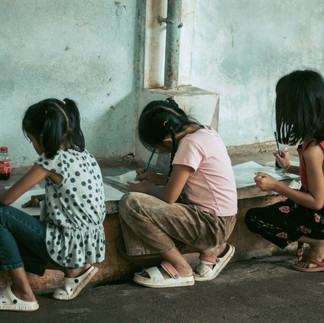Mata sa Mata
- Erich Marie Mendoza

- Aug 12, 2023
- 7 min read
When studying tropical cyclones, it is interesting to know how the eye can be the calmest part of all the typhoons we have experienced so far in our existence. In an archipelagic country where the emergence of natural disasters such as typhoons is unavoidably frequent, numerous families suffer incapacitating wounds derived from swelling grief directed to lives that have been lost and misplaced.
For every household that has witnessed how a typhoon closed its eye and shied away from them, children are forced to open their vulnerable eyes and discern the weight of disaster. For others, this could be a distant and fun recollection. But sometimes, once the repercussions would find their roots in the memories of a child, the body remembers while the influence of that particular calamity reflects in their eyes for each typhoon that will pass.
“Mata sang Bata, Mata sang Bagyo” is a children-centered program that involved several workshops and activities, including cathartic drawing and writing, an ephemeral art session, community singing and dancing, as well as fun-filled games. Every concept for this event was crafted by several individuals from different backgrounds and passions, collaborating to cater to the heart of the initiative— the children of Nueva Sevilla. In consideration of reality, this program does not aim to provide immediate ‘solutions’ for the challenges in the community revolving around typhoons. Instead, it is in pursuit to offer a safe avenue for children where they can tell their stories in ways that they are capable of; to allow them to own their narratives during disasters and listen to these in a world full of voices trying to speak for the children.
Nueva Sevilla is a barangay in Barotac Viejo that is often affected by strong typhoons in the region due to the geographical aspect of the place and the socioeconomic status of the locals. There were seventy children attendees alongside twenty-five adult leaders and facilitators who rendered the full-day program successful and memorable for everyone. Upon our arrival at the barangay covered court, some five to twelve-year-old participants were already sitting on monoblock chairs, waiting for their name tags. The children were a bit shy and hesitant during the initial interaction with some adult leaders since both parties were still trying to build a sense of familiarity and rapport with each other. It was a calm morning, although somehow gloomy because of the weather when the program began with children bearing their smiles and sincerity.
A particular kind of pureness emanating from the children makes you gravitate towards them without having to put a facade at the cost of interconnection. Among anything else, their presence does not demand you to be an established person﹘they do not care about what you have or what you lack for as long as you can communicate, gain their trust, and find a common understanding with them, even in mere silence. For Cathyrine Ballente, one of the adult leaders, this distinct characteristic propelled her to handle them delicately as much as possible and to intuitively cater to their needs by just looking at their eyes. It is inevitable for some children, especially at five years old, to hardly grasp the right words to express their thoughts and feelings. Consequently, when there is little to no verbal communication, all we are left with are their eyes which could make up for the absence of their words.
There was a space for the children's perception regarding their typhoon experiences in the various workshops facilitated by the artists. During cathartic drawing, participants depicted their reminiscences amidst a disaster through basic shapes and lines. These fundamental figures served as the collective foundation of their storytelling by providing them with the creative freedom to convey their narratives in a way that encompasses their capabilities. Some children explained their drawings where they shared how trees were uprooted, how their houses were destroyed, and how a five-year-old child, along with his family, fell over due to the impact of wind.

‘Manong Mata’ somewhat became a significant entity for the children as they put into words their pensive and hopeful wishes in the cathartic writing session. In the face of typhoons where children, especially those from disadvantaged families, are left with no choice but to witness, endure, and long for the disaster to be over, Manong Mata was established to whom they could comfortably relay what they yearn for. There were children whose hands were held and guided by several adult leaders in every stroke of the letter to form their wishes. In some cases, children whispered their hopes with an intangible trust and bond to their facilitators, who wrote them in their stead. To see them earnestly writing and to understand their emotions between the lines of their aspirations enabled me to perceive children through another lens: in their consciousness during disasters.

In the middle of the writing process, a participant asked me, “Nang, tuod na siya haw?”. I could not think of a direct and concrete answer to her question that could encapsulate the purpose of the workshop but would not disrupt her discernment of life at the same time. Manong Mata did not necessarily stem from a person yet rather a position or a system responsible for serving the community and its people. But this idea, in its rawest form, might be imposing on the children’s perspectives, and the sense of an authoritative structure may affect the genuineness of their stories. All I replied was, “Depende. Pero isulat lang ang gusto mo kay pwede guid na matuman.” — which is a possibility when someone is willing to attentively listen and connect to the grassroots.

Meanwhile, the manifestation of the children’s artistic imagination was visible through the ephemeral art workshop. Prompted by the question of what the eye of a typhoon looks like for the participants, each team gathered various materials within the vicinity for their installation. Every fragment of vision from a child seemed delineated in the form of leaves, stones, flowers, and twigs arranged together to actualize the semblance of an eye. The infusion of memories and perceptions of children in their outputs can imbue a sense of curiosity and mesmerization for the viewer. This art session, for all of its temporality, has marked a slippage of recollection and meanings for all the people involved in the program.


Jethro Bacrang’s original community song for “Mata sang Bata, Mata sang Bagyo” instantly became a crowd favorite and a point of merriment for the children. We allowed them to choose between kawayan patik-patik and dancing during the performance. The enthusiasm resonating inside the covered court while the song repeated did not waver as the children and the volunteers shared a passionate sensory experience. Moreover, the games also elevated the enjoyment and synergy of participants, mainly on bakwit (evacuate). Camaraderie began to find its ground for each team actively bound by cooperation and joyfulness.
As I soak myself in the warmth of this program, my mind spirals back to the girl gazing through the window pane while a typhoon wreaks havoc outside. I was eight years old when Yolanda struck the country. We used to have these enormous Gmelina trees that surrounded the house from which my siblings and I would pick out some fruits and leaves for our trivial games. No one in our family expected the typhoon to be that destructive since the weather was quite fair earlier that day. However, in the first few hours after Yolanda landed, I remember my mother covering our appliances with plastics as the temporary roofs that my father attached in our kitchen and living room were gradually blown away by the wind. We huddled in a room while watching the world slowly crumble to the typhoon. The enormity of it all went beyond the scale I could carry back then, and the tip that I was trying to tether to slipped when I saw those Gmelina trees tumble. To catch sight of something so comforting falling in front of me while our house was being reduced to its remnant seemed so tremendous and detrimental; it was like wanting to stop a rain that was forecasted; I could not get hold of anything, most especially that overwhelming feeling.
My older sister and I spent our days after the disaster removing linoleum to bail out the water that went inside and washing off the mud that clung to our utensils. My mother, on the other hand, frequently went to the gymnasium and barangay hall to line up for the rations given to the locals.
Now, at eighteen, almost a decade after Typhoon Yolanda, I still think of those trees whenever a typhoon passes by. At some point, I could vividly remember how the roots tried to clutch on the soil while the wind pulled it down. But, there are also times when my eyes linger on the ceiling, mind drifting back to those same fallen trees that were sawed off into dos por dos and were later on used to rebuild a part of our house.
For the second day of “Mata sang Bata, Mata sang Bagyo”, the artists and volunteers of Kikik Kollektive conducted a community mural at Nueva Sevilla covered court to mark the conclusion of the program. Up close, you could find doodles of various jovial things such as flowers, stuffed toys, slippers, and the sun on the iris and pupil of the painting. Meanwhile, the texts on the sclera (white part of the eyes) convey what may seem like desolate thoughts and circumstances rendered by the disaster. The juxtaposition of these aspects highlights the multifaceted nature of children’s perception regarding typhoons. Accounted to the insights of participants during the workshops, both positive and negative ideas were transmigrated into the mural.
When you take steps backward, those little details amalgamate with the different eye parts where they are situated. Consequently, once you are far enough from it, you are left with a child’s eyes full of ambiguity, gazing right back at you amid a typhoon.
And so, just like how distinct narratives could find their space in the eyes of participants, we could only hope that the essence of this program may also take root in them, especially when the children and typhoon meet through mata sa mata.












































































































Comments